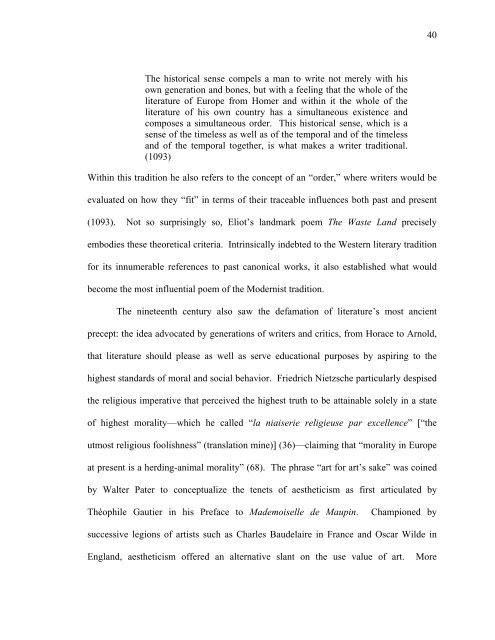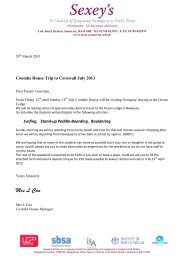Untitled - Sexey's School Moodle
Untitled - Sexey's School Moodle
Untitled - Sexey's School Moodle
You also want an ePaper? Increase the reach of your titles
YUMPU automatically turns print PDFs into web optimized ePapers that Google loves.
The historical sense compels a man to write not merely with his<br />
own generation and bones, but with a feeling that the whole of the<br />
literature of Europe from Homer and within it the whole of the<br />
literature of his own country has a simultaneous existence and<br />
composes a simultaneous order. This historical sense, which is a<br />
sense of the timeless as well as of the temporal and of the timeless<br />
and of the temporal together, is what makes a writer traditional.<br />
(1093)<br />
Within this tradition he also refers to the concept of an “order,” where writers would be<br />
evaluated on how they “fit” in terms of their traceable influences both past and present<br />
(1093). Not so surprisingly so, Eliot’s landmark poem The Waste Land precisely<br />
embodies these theoretical criteria. Intrinsically indebted to the Western literary tradition<br />
for its innumerable references to past canonical works, it also established what would<br />
become the most influential poem of the Modernist tradition.<br />
The nineteenth century also saw the defamation of literature’s most ancient<br />
precept: the idea advocated by generations of writers and critics, from Horace to Arnold,<br />
that literature should please as well as serve educational purposes by aspiring to the<br />
highest standards of moral and social behavior. Friedrich Nietzsche particularly despised<br />
the religious imperative that perceived the highest truth to be attainable solely in a state<br />
of highest morality—which he called “la niaiserie religieuse par excellence” [“the<br />
utmost religious foolishness” (translation mine)] (36)—claiming that “morality in Europe<br />
at present is a herding-animal morality” (68). The phrase “art for art’s sake” was coined<br />
by Walter Pater to conceptualize the tenets of aestheticism as first articulated by<br />
Théophile Gautier in his Preface to Mademoiselle de Maupin. Championed by<br />
successive legions of artists such as Charles Baudelaire in France and Oscar Wilde in<br />
England, aestheticism offered an alternative slant on the use value of art. More<br />
40



